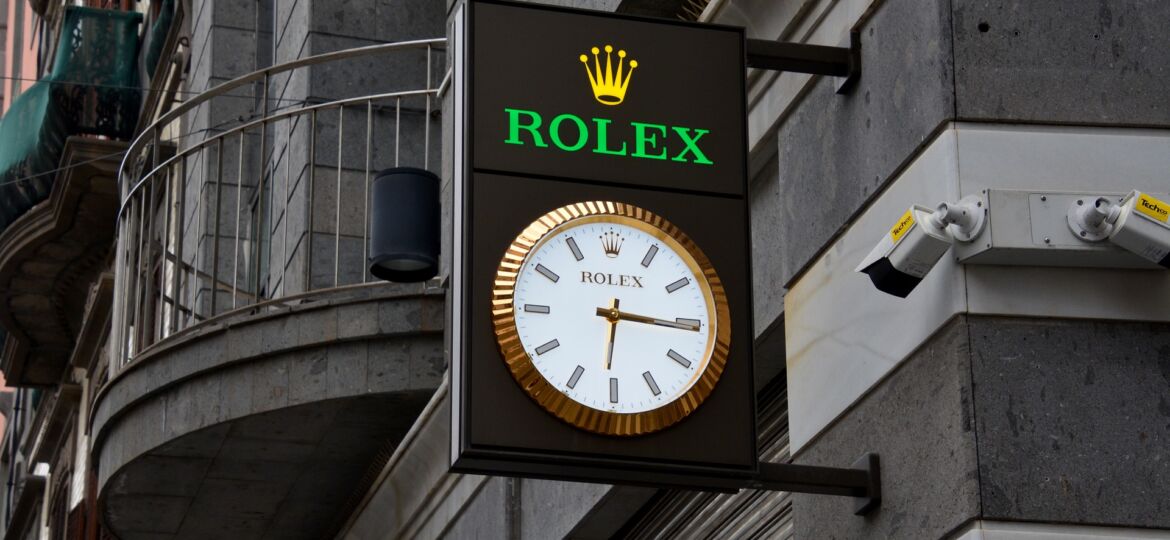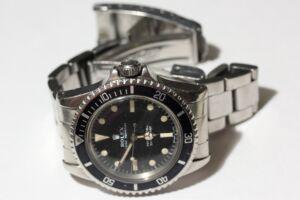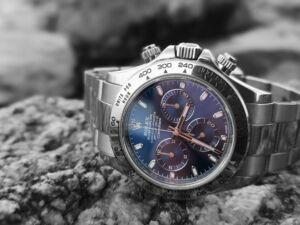
Rolex, the Swiss luxury watchmaker, is a name that invokes images of precision, craftsmanship, and timeless elegance. With a history spanning over a century, the brand has consistently remained at the forefront of innovation and design, leading the watch industry into uncharted territories. In this in-depth exploration, I will delve into the illustrious past of Rolex, examine its present-day success, and anticipate what the future holds for this iconic brand.
- The Early Days: Hans Wilsdorf’s Vision
The story of Rolex began in 1905 when Hans Wilsdorf, a German entrepreneur with a passion for precision and perfection, founded Wilsdorf & Davis in London. Partnering with his brother-in-law, Alfred Davis, Wilsdorf set out to create wristwatches that were not only reliable and accurate but also elegant and stylish.
In 1908, Wilsdorf registered the name “Rolex” as a trademark. The name, chosen for its simplicity and ease of pronunciation in various languages, soon became synonymous with the brand’s commitment to quality. In 1910, a Rolex watch earned the world’s first wristwatch chronometer certification from the Official Watch Rating Center in Bienne, Switzerland. This groundbreaking achievement cemented the brand’s reputation for precision.
- The Oyster Case: A Revolution in Watchmaking

In 1926, Rolex introduced the world’s first waterproof and dustproof watch, the Oyster. The patented Oyster case, featuring a hermetically sealed winding crown and a screw-down case back, protected the watch’s delicate movement from external elements, ensuring its precision and reliability. The Oyster’s innovative design was put to the test in 1927 when Mercedes Gleitze, an English swimmer, successfully swam the English Channel wearing the timepiece. The watch’s performance during this historic feat captured the public’s imagination and set the stage for Rolex’s continued success.
- Perpetual Movement: The Birth of the Self-Winding Watch
In 1931, Rolex unveiled another groundbreaking innovation: the Perpetual rotor, a self-winding mechanism that harnessed the wearer’s natural wrist movements to power the watch. This invention eliminated the need for manual winding and enhanced the watch’s accuracy and reliability. The Perpetual movement became the foundation for future Rolex models, solidifying the brand’s reputation for cutting-edge technology.
- Pioneering Innovations: Setting New Standards
Rolex’s history is marked by a relentless pursuit of innovation. In 1945, the brand unveiled the Datejust, the first wristwatch with an automatically changing date on the dial. This groundbreaking feature, combined with the Perpetual movement, made the Datejust a favorite among watch enthusiasts.
In 1953, Rolex introduced the Submariner – the first divers’ watch waterproof to a depth of 100 meters (330 feet). The Submariner’s robust construction, rotating bezel, and luminescent markers made it an essential tool for divers and a symbol of adventure.
The brand’s pioneering spirit continued with the introduction of the GMT-Master in 1955. Designed for intercontinental travelers and pilots, the GMT-Master allowed wearers to read the time in two different time zones simultaneously, thanks to its innovative 24-hour rotating bezel and an additional hour hand.
- The Rolex Daytona and the Racing World

In 1963, Rolex launched the Cosmograph Daytona, a high-performance chronograph designed for professional race car drivers. The watch’s tachymetric scale, precise chronograph functions, and reliable movement made it an instant favorite among racing enthusiasts. Named after the famous Daytona International Speedway in Florida, the Daytona became synonymous with speed, precision, and the adrenaline-fueled world of motorsports.
The Rolex Daytona’s distinctive design features a large, easy-to-read dial with three sub-dials for measuring elapsed time, a tachymetric bezel for calculating speed, and screw-down pushers to ensure water resistance. Over the years, the Daytona has undergone several updates and improvements, while maintaining its iconic aesthetics and mechanical prowess.
One of the most famous Daytona models is the reference 6239, also known as the “Paul Newman Daytona.” This particular model, distinguished by its unique dial design with contrasting sub-dials and an outer track, was popularized by the legendary actor and racing enthusiast Paul Newman. Newman’s personal Daytona, which he wore regularly, sold at auction in 2017 for a record-breaking $17.8 million, further cementing the watch’s status in the world of horology and popular culture.
Rolex’s commitment to the racing world extends beyond the creation of the Daytona. The brand has formed partnerships with numerous racing events and organizations, such as the 24 Hours of Le Mans, the Rolex 24 at Daytona, and the FIA World Endurance Championship. These collaborations allow Rolex to showcase its passion for motorsports and demonstrate the reliability and precision of its timepieces in the most demanding environments.
Over the years, the Rolex Daytona has become a highly sought-after timepiece, both for its connection to the racing world and its impeccable design and functionality. The Daytona’s legacy as a symbol of performance and endurance is a testament to Rolex’s dedication to innovation and excellence. As the world of racing continues to evolve, the Rolex Daytona remains a constant, enduring icon that celebrates the spirit of competition and the pursuit of perfection.
- Rolex and Exploration: Conquering New Frontiers
Rolex’s commitment to innovation and exploration was further cemented when the brand accompanied Sir Edmund Hillary and Tenzing Norgay on their historic ascent of Mount Everest in 1953. The Oyster Perpetual timepieces worn by the climbers withstood the extreme conditions, proving their durability and reliability. This accomplishment led to the development of the Rolex Explorer, a watch designed specifically for those who push the boundaries of human achievement.
In 1960, the Rolex Deep Sea Special accompanied the bathyscaphe Trieste to the bottom of the Mariana Trench, the deepest point in the world’s oceans. The watch withstood immense pressure at a depth of 10,916 meters (35,814 feet), showcasing Rolex’s commitment to creating timepieces that can endure the harshest environments.
- The Role of Rolex in Popular Culture

Rolex’s prominence extends beyond the horology world; it has become a cultural icon. Worn by famous actors, musicians, and sports stars, Rolex timepieces have graced the wrists of icons like Paul Newman, Steve McQueen, and Sir Edmund Hillary. The brand’s association with James Bond, starting with Sean Connery’s portrayal in the 1962 film “Dr. No,” further solidified its status as a symbol of luxury and style.
Rolex watches have also made appearances in numerous films, such as “The Great Escape,” “Apocalypse Now,” “Titanic,” and “The Wolf of Wall Street,” to name a few. These appearances in popular culture have helped to elevate the brand’s image and establish its place as a symbol of success and achievement.
- Rolex’s Philanthropy and Sponsorship
Rolex’s commitment to excellence extends to its philanthropic endeavors and sponsorships. The Rolex Mentor and Protégé Arts Initiative, established in 2002, fosters the growth of young talents in various artistic fields by pairing them with established masters in their respective disciplines. This initiative has helped launch the careers of numerous emerging artists, further showcasing Rolex’s dedication to supporting the arts.
Rolex also sponsors prestigious sporting events and organizations, such as Wimbledon, the Formula 1 World Championship, and the Rolex Sydney Hobart Yacht Race. The brand’s support for these events speaks to its dedication to achievement, precision, and excellence.
- Environmental Commitment and Sustainability
As a responsible corporate citizen, Rolex is committed to minimizing its environmental impact and promoting sustainable practices. The brand has implemented a comprehensive environmental management system at its production sites, focusing on reducing waste, conserving energy, and managing resources responsibly.
Rolex is also a long-standing supporter of the National Geographic Society, the Cousteau Society, and other organizations that promote environmental awareness and conservation efforts. Through these partnerships, Rolex supports scientific research and exploration aimed at preserving our planet for future generations.
- The Future of Rolex: Evolving with the Times

Rolex’s future remains bright as the brand continues to set the standard in watchmaking. With a dedication to research and development, Rolex consistently pushes the boundaries of horology, ensuring its timepieces remain at the cutting edge of precision and innovation. As consumer preferences evolve, the brand is poised to embrace new technologies and materials, while maintaining its core values of quality, reliability, and elegance.
Conclusion
The Rolex legacy is a testament to the brand’s unwavering pursuit of excellence and its commitment to innovation. From its early days to the present and into the future, Rolex continues to inspire with its iconic timepieces, shaping the watch industry and leaving an indelible mark on our culture. Rolex’s illustrious past, its present-day success, and its promising future serve as a shining example of the power of dedication, vision, and craftsmanship. As Rolex continues to push the boundaries of horology and maintain its status as a cultural icon, the brand remains steadfast in upholding its core values of quality, reliability, and elegance. In a world that is constantly evolving, Rolex stands as a symbol of timeless innovation, a legacy that will continue to inspire generations to come.